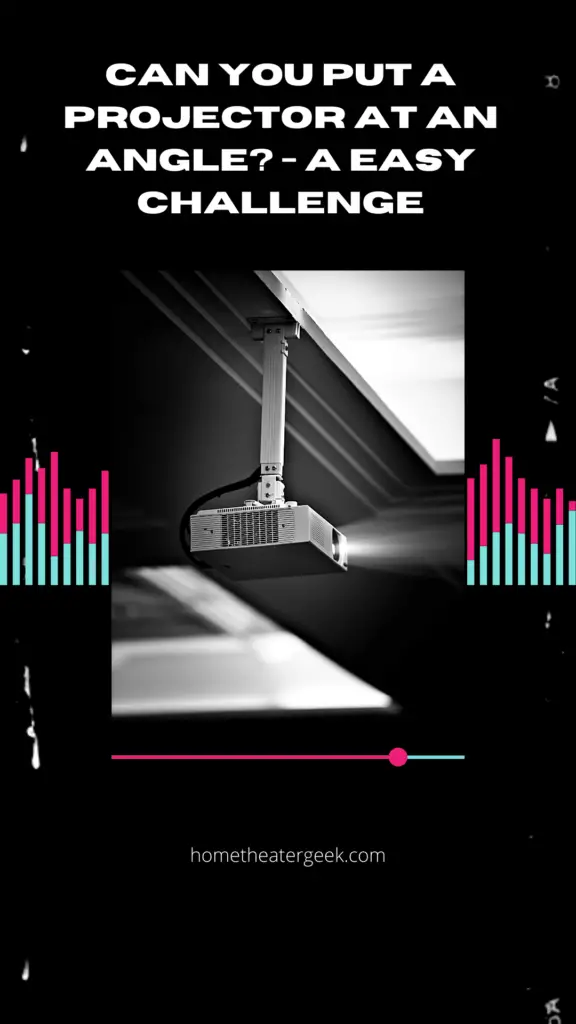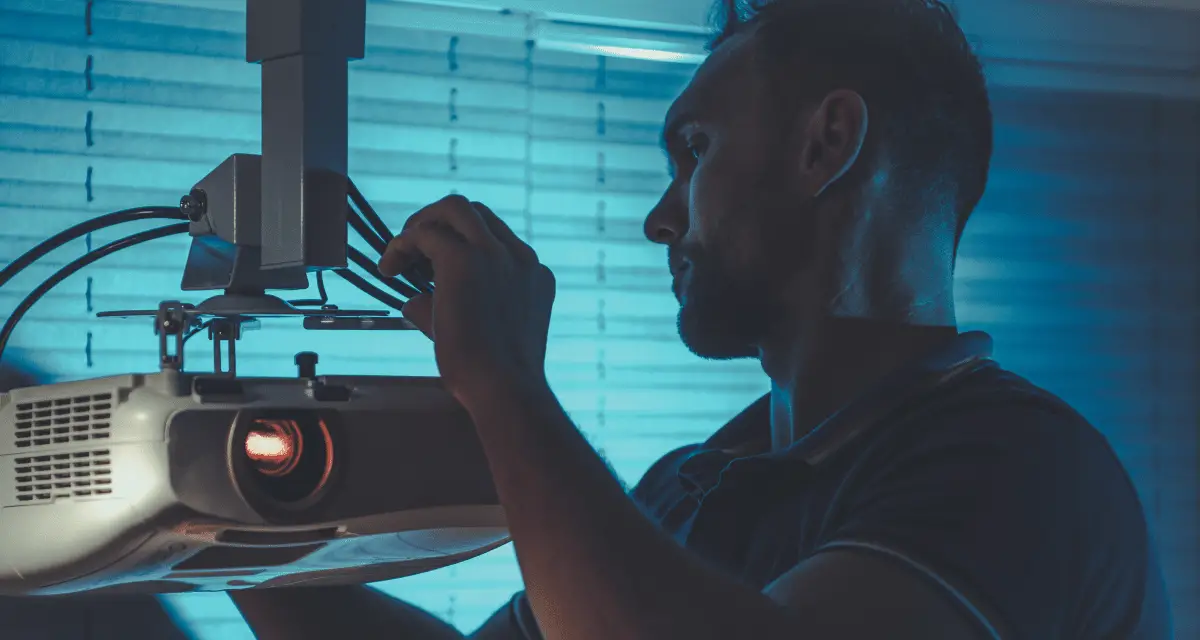We hope you love the products we recommend! Just so you know, we may collect a share of sales or other compensation from the links on this page. Thank you if you use our links, we really appreciate it!
Can you put a projector at an angle? This is a question that many people have asked, and the answer is not as straightforward as you may think. In this blog post, we will take a look at some of the factors involved in choosing a projection angle, and offer some tips on how to find the right one for your needs. So, can you put a projector at an angle? Keep reading to find out!

Table of Contents
Can You Put A Projector At An Angle?
One of the most common questions we get asked is whether it’s possible to project at an angle. The short answer is yes, you can put a projector at an angle, but there are a few things you need to take into account before you do. The first is that the image will be distorted if the projector is not perpendicular to the screen. This is because the light from the projector is projected in a cone, and if the projector is not pointing directly at the screen, the edges of the image will be cut off.
The second thing to consider is that the image will be brighter in the center than at the edges. This is because the light from the projector is not evenly distributed across the entire surface of the lens. As a result, if you put a projector at an angle, you may need to adjust the brightness settings to compensate for this.
Finally, you also need to make sure that there is enough space behind the projector so that it can project onto the screen without being blocked by objects in the room. If you take these factors into account, then you should have no problem projecting at an angle.
How to use a projector at an angle?
You can use a projector at an angle by placing it on a tripod or shelf. You will need to adjust the projector’s focus and keystone settings to get the best image possible. It is also important to make sure that the projector is level so that the image is not distorted.
Another way to use a projector at an angle is to use a mirror. This will allow you to project the image onto a wall or screen that is at an angle. You can also use a special lens that is designed for projecting at an angle. These lenses are called fisheye lenses.
No matter which method you use, it is important to make sure that the projector is level so that the image is not distorted. You will also need to adjust the focus and keystone settings to get the best possible image.
The Keystone correction and lens shifting feature on the projector allows you to use the projector at an angle, or when the projector is placed off-center. This is helpful when you want to project onto a surface that is not level with the ground, such as a wall or ceiling.
To use the Keystone correction and lens shifting feature, first make sure that the projector is turned on and in focus. Then, using the remote control, press the “Menu” button. Next, select the “Keystone Correction” option from the menu. You will then be able to adjust the keystone correction by pressing the “Up” or “Down” arrow keys.
To use the lens shifting feature, press the “Menu” button again and select the “Lens Shift” option from the menu. You will then be able to adjust the lens shift by pressing the “Left” or “Right” arrow keys.
The Keystone correction and lens shifting feature can be used together or separately, depending on your needs. If you are unsure of how to use either feature, consult the user manual for more information. Some highly recommended projectors include:
| Image | Product | Feature | Price |
|---|---|---|---|
|
Editor Choice
 |
Optoma UHD38 Bright Projector
|
|
Check Price |
|
TOP Pick
 |
Acer C250i Anytime, Any Angle Full HD Projector
|
|
Check Price |
|
Trending
 |
ViewSonic M1 Mini+ Ultra Portable
|
|
Check Price |
The Benefits of Using a Projector at an angle
A projector at an angle can offer many benefits over a traditional projector. By angling the projector, you can create a more immersive experience for your audience, as well as increase the brightness of the image and improve contrast. Additionally, an angled projector can help reduce eyestrain for viewers by directing light directly into their eyes, rather than across the room. Projectors at angle can also help reduce glare and improve the overall clarity of the image.
A projector can be used in a variety of lighting conditions, whereas a television or monitor typically needs to be used in darkened rooms. This means that you can use a projector in rooms with ambient light, such as living rooms or offices.
Disadvantages of using a projector at an angle
One of the potential disadvantages of using a projector at an angle is that the image can appear distorted. This is because the projector’s lens is not designed to project the image at an angle, so the light is not focused correctly and the image appears blurry. Additionally, if the projector is not level with the screen, the image will be projected at an angle and will appear distorted.
Another potential disadvantage is that the projector may not be able to project the entire image if it is angled too far up or down. This can be a particular problem if the screen is large or if the projector is placed at a distance from the screen.
Finally, depending on the type of projector, using it at an angle can result in a loss of brightness and contrast. This is because the light is not being projected directly onto the screen, so some of it is lost in the process. Overall, using a projector at an angle can be problematic and it is generally best to avoid doing so if possible.
How To Choose The Right Projector For Angle Needs?
Projectors have come a long way in recent years. No longer are they bulky, expensive and difficult to use. Today’s projectors are small, lightweight and easy to set up. And with the advent of LED and laser light sources, they’re also more energy-efficient than ever before. Whether you’re looking for a projector for your home theater or office presentation room, there’s a model out there that’s perfect for your needs. Here’s a quick guide to help you choose the right projector for your application.
First, consider the environment in which the projector will be used. Home theater projectors are designed for use in dark rooms, while office and classroom projectors work best in dim or well-lit environments. If you’ll be using the projector primarily for movies or video games, image quality is paramount. Look for a projector with 1080p (1920 x 1080) resolution or higher. If you need a projector for PowerPoint presentations or web browsing, however,720p (1280 x 720) resolution should be sufficient.
Conclusion
In conclusion, it is possible to put a projector at an angle. By doing so, you can increase the size of the projected image. However, there are some things to consider before making this decision. We hope that this article has helped you better understand how projectors work and what options are available to you when choosing one for your needs.

